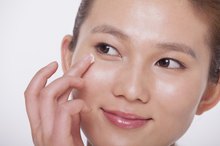What does fact checked mean?
At Healthfully, we strive to deliver objective content that is accurate and up-to-date. Our team periodically reviews articles in order to ensure content quality. The sources cited below consist of evidence from peer-reviewed journals, prominent medical organizations, academic associations, and government data.
- Clinics in Dermatology; Cosmeceuticals: Focus on Topical Retinoids in Photoaging; R. Serri et al.; November-December 2008
- Clinics in Dermatology; Cosmeceuticals: Focus on Topical Retinoids in Photoaging; R. Serri et al.; November-December 2008
The information contained on this site is for informational purposes only, and should not be used as a substitute for the advice of a professional health care provider. Please check with the appropriate physician regarding health questions and concerns. Although we strive to deliver accurate and up-to-date information, no guarantee to that effect is made.
The Difference Between Retinol and Retin-A
As you age, fine lines and wrinkles begin to form and your skin loses its smoothness and elasticity. Years of sun exposure also cause changes in your complexion. Skincare companies and drug companies have released numerous products that contain derivatives of vitamin A with the promise of preventing and reversing these signs of aging. Two popular forms are retinol and Retin-A, the brand name for a form of retinoic acid. The two are often believed to be interchangeable, but the main difference is that retinol is eventually converted into retinoic acid.
Retinol
Retinol is a natural form of vitamin A, while Retin-A is derived from retinoic acid, a synthetic derivative of vitamin A, and considered pharmaceutical. Retinol is formed in the body by the hydrolysis of retinyl esters. It is the most common form of vitamin A used in over-the-counter skincare products, in concentrations of 0.075 to 1 percent. Manufacturers of these products suggest that retinol will help get rid of or improve the appearance of wrinkles. However, retinol does not have much direct effect on the skin, because it must first be converted by enzymes into retinoic acid. The conversion rate of retinol to retinoic acid is quite slow and varies among individuals.
- Retinol is a natural form of vitamin A, while Retin-A is derived from retinoic acid, a synthetic derivative of vitamin A, and considered pharmaceutical.
- However, retinol does not have much direct effect on the skin, because it must first be converted by enzymes into retinoic acid.
Retin A
Retin-A 0.025 Cream Used for Wrinkles
Learn More
Retin-A is the brand name for tretinoin. Unlike retinol, Retin-A is only available by prescription. It is mainly prescribed as an acne treatment, at concentration levels ranging from 0.01 to 0.1 percent, depending on your skin type. Retin-A is much stronger than retinol, and also has a direct effect as a skin treatment. By providing a light chemical peel, Retin-A helps speed up the natural exfoliation process and enhance collagen production.
- Retin-A is the brand name for tretinoin.
- Retin-A is much stronger than retinol, and also has a direct effect as a skin treatment.
Clinical Studies
**According to a review of clinical studies published in the November/December 2008 issue of "Clinics in Dermatology," Retin A must be used daily for at least three months to achieve maximum results 1. Within one month you will begin to notice improvement in the appearance and smoothness of your skin. Retinol does not appear to be as effective as Retin-A in improving signs of aging.
Side Effects
Maxi Peel Ingredients
Learn More
Before using a new skincare product, find out about its side effects, if any. Side effects of Retin-A include redness, peeling, dryness and flaking of the skin. The side effects associated with Retin-A are caused by its very strong effect on skin cell differentiation. Conversely, retinol has much milder effect on the skin, so adverse reactions are rare. Retinol has been suggested as a good alternative for those with sensitive skin.
- Before using a new skincare product, find out about its side effects, if any.
- The side effects associated with Retin-A are caused by its very strong effect on skin cell differentiation.
Related Articles
References
- Clinics in Dermatology; Cosmeceuticals: Focus on Topical Retinoids in Photoaging; R. Serri et al.; November-December 2008
- McDaniel DH, Mazur C, Wortzman MS, Nelson DB. Efficacy and tolerability of a double-conjugated retinoid cream vs 1.0% retinol cream or 0.025% tretinoin cream in subjects with mild to severe photoaging. Journal of Cosmetic Dermatology. 2017 Dec;16(4):542-548. doi:10.1111/jocd.12381
- American Osteopathic College of Dermatology. Retinoids, topical.
- O'Byrne SM, Blaner WS. Retinol and retinyl esters: biochemistry and physiology. J Lipid Res. 2013;54(7):1731‐1743. doi:10.1194/jlr.R037648
- NIH MedlinePlus. Tretinoin topical. Updated March 15, 2019.
- Zaenglein AL, Pathy AL, Schlosser BJ, Alikhan A, Baldwin HE, et. al. Guidelines of care for the management of acne vulgaris. Journal of the American Academy of Dermatology. 2016;74(5):945-73. doi:10.1016/j.jaad.2015.12.037
- Nohynek GJ. Commentary on the safety of topical vitamin A in cosmetics. Regululatory Toxicology and Pharmacology. 2017;89:302-304. doi:10.1016/j.yrtph.2017.08.002
Writer Bio
Melissa Biscardi has been writing health related articles since 2007. Her articles have appeared in such publications as "Alzheimer's Care Today" and "Topics in Geriatric Rehabilitation." Biscardi has a Bachelor of Science in nursing from Ryerson University in Toronto. She also completed a pre-doctoral internship focusing of prevention of neurotrauma in newborns at the Institute of Child Study.









